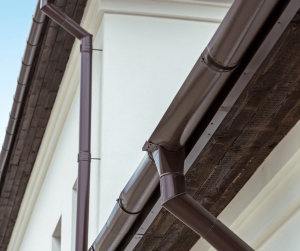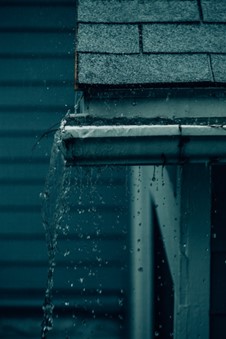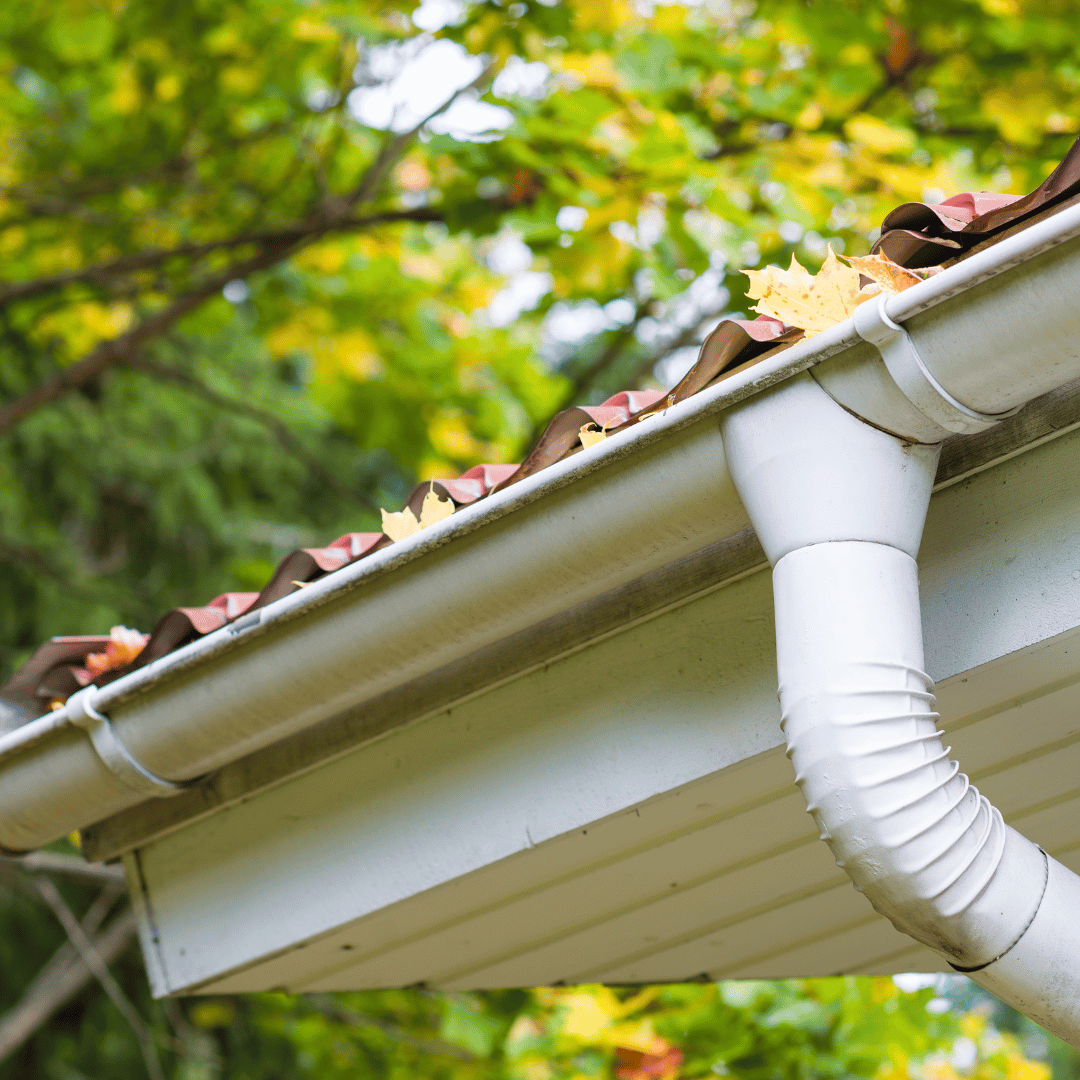
Gutter Downspout Cleaning
Maintaining clean gutter downspouts is crucial for the overall health and longevity of your home. Over time, debris such as leaves, twigs, and dirt can accumulate in gutters, leading to clogged downspouts. This not only affects the aesthetic appeal of your property but also poses risks of water damage to the foundation, walls, and landscaping.
In this comprehensive guide to gutter downspout cleaning, we’ll explore effective methods to ensure your downspouts remain clear and functional throughout the year. From basic cleaning techniques to tackling downspouts that go underground, we’ll provide practical advice to help you maintain a well-functioning gutter system.
By understanding the importance of regular maintenance and employing the right cleaning strategies, you can protect your home from potential water-related issues and avoid costly repairs down the line. Let’s dive into the details of keeping your gutter downspouts clean and efficient.
How to Clean a Gutter Downspout
Cleaning gutter downspouts is a critical part of overall gutter maintenance. Here’s a step-by-step guide on how to effectively clean your gutter downspout:
Gather Your Tools and Safety Gear:
- Tools: You’ll need a sturdy ladder, work gloves, a gutter scoop or trowel, a bucket or bag for debris collection, and a garden hose with a nozzle attachment.
- Safety Gear: Wear safety goggles to protect your eyes from debris and gloves to safeguard your hands.
Position Your Ladder Safely:
- Place your ladder on stable ground and ensure it’s positioned securely against the house. Avoid leaning the ladder directly against the gutter to prevent damaging it.
Remove Debris from the Gutter:
- Start by scooping out leaves, twigs, and other debris from the gutter using a gutter scoop or trowel. Place the debris into your bucket or bag for easy disposal later.
Clear the Downspout Entrance:
- Check the entrance of the downspout for any blockages. Use your hands or a small tool to clear away any debris that may be clogging the opening.
Flush the Downspout with Water:
- Once the gutter is clear, use a garden hose with a nozzle attachment to flush water through the downspout. Start from the top near the gutter and work your way down to ensure all debris is flushed out.
Check for Proper Drainage:
- While flushing the downspout, observe if water flows freely out of the bottom. If water doesn’t drain properly, there may still be a clog further down the downspout or in the underground pipes.
Repeat if Necessary:
- If you encounter stubborn clogs, repeat the process of scooping out debris and flushing with water until the downspout is completely clear.
Inspect and Secure Gutters:
- After cleaning, inspect the entire gutter system for any damage or loose parts. Secure any loose gutter sections or downspout brackets to ensure stability.
Regularly cleaning your gutter downspouts helps prevent water backup and potential damage to your home’s exterior and foundation. Now that you know how to clean a gutter downspout effectively, let’s explore how to tackle downspouts that go into the ground in the next section.
How to Unclog a Gutter Downspout that Goes into the Ground
Cleaning a gutter downspout that extends into the ground requires careful attention to ensure proper drainage. Here’s how to tackle this task effectively:
- Locate the Downspout Exit:
- Identify where the downspout exits near the ground. This may involve checking along the perimeter of your home or the edge of your property.
- Clear the Above-Ground Portion:
- Begin by clearing any debris or blockages from the visible, above-ground portion of the downspout. Use your hands or a small tool to remove leaves, sticks, or other materials.
- Use a Plumbing Snake or Hose:
- If the clog persists, use a plumbing snake or a high-pressure hose to attempt to dislodge the blockage. Insert the snake into the downspout and carefully maneuver it to break up the obstruction.
- Flush with Water:
- Once you’ve loosened the clog, flush the downspout with a strong stream of water from a garden hose. Direct the water down the downspout to clear out remaining debris and ensure proper flow.
- Check for Proper Drainage:
- Observe the water flow at the exit point of the downspout. Ensure that water is draining freely away from the foundation of your home to prevent any potential water damage.
- Repeat if Necessary:
- If the downspout remains clogged, repeat the process of clearing and flushing until water flows smoothly through the downspout.
- Inspect and Maintain:
- After clearing the downspout, inspect the area around the exit point for any signs of damage or further blockages. Maintain a regular schedule of gutter and downspout cleaning to prevent future issues.
Cleaning and unclogging gutter downspouts that go into the ground are essential tasks in maintaining proper drainage around your home. Next, we’ll explore how to clean a gutter downpipe to ensure your entire gutter system functions effectively.
Cleaning a Gutter Downpipe
Cleaning a gutter downpipe is crucial for maintaining proper drainage and preventing issues like blockages and water damage to your home. Here’s a guide on how to clean a gutter downpipe effectively, along with recommended cleaning solutions and equipment:
Methods to Clean the Entire Downpipe Effectively:
Inspect and Clear Debris:
- Begin by visually inspecting the downpipe for any visible debris such as leaves, twigs, or dirt.
- Use a ladder to access the gutter and downpipe safely.
- Remove larger debris by hand or with a small garden trowel. Be cautious to avoid pushing debris further into the downpipe.
Flush with Water:
- After removing visible debris, use a garden hose with a nozzle attachment or a pressure washer to flush the downpipe.
- Start from the top near the gutter and work your way downwards.
- The water pressure helps dislodge and push out any remaining dirt, small debris, or stuck particles.
Use a Plumbing Snake or Auger:
- If the downpipe remains clogged despite flushing, use a plumbing snake or auger specifically designed for gutter pipes.
- Insert the snake into the downpipe and rotate it to break up and remove stubborn blockages.
Check Drainage:
- Once cleaned, check the flow of water through the downpipe by running the hose or pouring water into the gutter.
- Ensure water flows smoothly through the downpipe without backing up or leaking.
Recommended Cleaning Solutions and Equipment:
Cleaning Solutions:
- Mild Detergent: Use a gentle dish soap or a specialized gutter cleaning solution diluted in water to help dissolve dirt and grime.
- Vinegar Solution: A mixture of vinegar and water can also be effective for breaking down organic matter.
Cleaning Equipment:
- Garden Hose with Nozzle: Provides the water pressure needed to flush out debris effectively.
- Pressure Washer: Ideal for more stubborn dirt and debris, but use on a lower setting to avoid damaging the gutter or downpipe.
- Ladder: Ensure it’s stable and secure before climbing to reach the gutter and downpipe.
- Garden Trowel or Scoop: For manually removing larger debris from the gutter and around the downpipe entrance.
- Plumbing Snake or Auger: Specifically designed for navigating through and clearing clogs in downpipes.
Safety Precautions:
- Always use a sturdy ladder and have someone else present when working at height.
- Wear gloves and protective eyewear to shield yourself from debris and cleaning solutions.
- Avoid using harsh chemicals that could damage the gutter or downpipe material.
By following these methods and using the recommended solutions and equipment, you can effectively clean your gutter downpipe, ensuring optimal drainage and preventing potential water damage to your home. Regular maintenance of gutters and downpipes is key to their longevity and functionality.
Guidelines on How Often Downspouts Should Be Cleaned:
Seasonal Cleaning:
- Twice a Year: It’s generally recommended to clean your gutters and downspouts at least twice a year, typically in the spring and fall. These times coincide with when leaves, seeds, and other debris are most likely to accumulate in gutters.
After Severe Weather:
- After Heavy Rain or Storms: Check and clean downspouts if there has been heavy rainfall or severe weather conditions. Storms can bring in debris and cause blockages quickly.
Regular Inspections:
- Every 3-4 Months: Perform visual inspections every few months to check for any signs of clogging or issues. If you notice any blockages or reduced water flow, clean the downspouts promptly.
Factors Influencing Cleaning Frequency:
Surrounding Trees:
- Proximity to Trees: If your home is surrounded by trees, especially deciduous trees that shed leaves, you may need to clean your downspouts more frequently. Leaves and twigs can quickly accumulate and cause blockages.
Climate and Weather Conditions:
- Heavy Rainfall: Areas prone to heavy rainfall or storms may require more frequent cleaning, as debris can wash into the gutters and downspouts more frequently.
- Freezing Conditions: In colder climates, ice dams can form in gutters and downspouts, leading to blockages. Cleaning before winter and after thawing periods is crucial.
Gutter Maintenance:
- Gutter Condition: Well-maintained gutters with gutter guards or screens may require less frequent cleaning. These devices help prevent large debris from entering the gutter system, reducing the frequency of downspout cleaning.
Presence of Wildlife or Pests:
- Nesting: Birds, squirrels, and other wildlife may build nests or leave debris in gutters and downspouts, necessitating more frequent cleaning.
Importance of Regular Cleaning:
- Preventing Water Damage: Clogged downspouts can cause water to back up into the gutter system and overflow, potentially damaging your roof, siding, and foundation.
- Maintaining Structural Integrity: Proper water drainage helps prevent the accumulation of water near the foundation, which can lead to cracks and structural issues over time.
- Preserving Landscaping: Clear downspouts ensure that water is directed away from landscaping and prevents erosion or waterlogging.
Regularly cleaning your downspouts not only ensures the efficient functioning of your gutter system but also extends its lifespan and reduces the risk of costly repairs. By following these guidelines and considering the influencing factors, you can determine the appropriate cleaning frequency for your home’s downspouts.
Best Time of Year for Gutter Cleaning
Choosing the best time of year for gutter cleaning is crucial for maintaining the integrity of your home and ensuring proper water drainage. Here’s a breakdown of seasonal considerations and the benefits of scheduling cleanings during specific seasons:
Seasonal Considerations for Gutter Maintenance:
Spring:
- After Winter Thaw: Spring is an ideal time to clean gutters, especially in regions that experience freezing temperatures during winter. It allows you to remove debris that accumulated over the colder months and check for any damage caused by ice or snow.
- Preparation for Rainy Season: Cleaning in spring prepares your gutters for the upcoming rainy season, ensuring they can handle heavy rainfall without overflow or blockages.
Fall:
- Leaf Shedding: Fall is traditionally the most critical time for gutter cleaning due to leaves falling from trees. Regular cleaning prevents leaves from clogging gutters and downspouts, which can lead to water damage and ice dams in winter.
- Preventing Winter Ice Dams: Clearing gutters before winter helps prevent ice dams, which form when melting snow refreezes in clogged gutters, potentially causing roof damage.
Summer:
- Post-Spring Storms: After spring storms, summer cleaning ensures that any debris washed into the gutters is removed, maintaining proper drainage.
- Inspecting and Repairing: Summer is a good time to inspect gutters for any damage or wear that may have occurred during spring rains.
Winter:
- Prevent Ice Dams: In colder climates, cleaning gutters in late fall or early winter can help prevent ice dams by ensuring gutters are clear of debris before snowfall.
- Safety Considerations: Cleaning gutters in winter should be done cautiously, considering the risks of ice and slippery conditions.
Benefits of Scheduling Cleanings During Specific Seasons:
- Maximize Effectiveness: Cleaning gutters at the right time ensures they are clear and functioning optimally before weather conditions change and potentially cause damage.
- Prevent Damage: Regular cleaning prevents water overflow, which can damage roofs, siding, and foundations, saving you from costly repairs.
- Extend Gutter Lifespan: Proper maintenance prolongs the lifespan of gutters, reducing the need for premature replacement.
- Maintain Curb Appeal: Clean gutters enhance the appearance of your home and prevent unsightly stains and damage to exterior surfaces.
- Safety: Regular maintenance reduces the risk of accidents caused by clogged gutters and slippery conditions during cleaning.
The best time for gutter cleaning depends on your climate and local weather patterns. By scheduling cleanings strategically throughout the year, you can ensure your gutters remain clear and effective in managing water runoff from your roof, protecting your home from water damage and maintaining its structural integrity. Regular maintenance is key to preserving the value and appearance of your property.
Are Downspout Cleanouts Worth It?
Deciding whether downspout cleanouts, especially through professional services, are worth it depends on several factors, including convenience, expertise required, and the condition of your gutter system. Here’s an exploration of the pros and cons of professional cleanout services versus DIY options:
Pros of Professional Cleanout Services:
Expertise and Equipment:
- Thorough Cleaning: Professionals have specialized tools and equipment, such as high-pressure washers or augers, that can effectively clear even stubborn clogs and debris.
- Knowledgeable Inspection: They can also inspect gutters and downspouts for damage or potential issues that may require repair or maintenance.
Time-Saving:
- Hiring professionals saves you time and effort, especially if you have a busy schedule or lack the necessary equipment for thorough cleaning.
Safety:
- Professionals are trained in working at heights and handling potentially hazardous materials like mold or pests that may accumulate in clogged gutters.
Comprehensive Service:
- They can provide a comprehensive service that includes not only cleaning but also minor repairs and adjustments to ensure optimal gutter performance.
Cons of Professional Cleanout Services:
- Cost:
- Professional services can be more expensive compared to DIY methods, especially for routine maintenance tasks that may seem straightforward.
- Dependency:
- Depending on professionals may mean scheduling appointments and waiting for availability, which could be inconvenient if urgent cleaning is needed.
DIY vs. Professional Cleanout Options:
DIY Options:
- Cost-Effective:
- DIY cleaning can save money, especially for routine maintenance tasks like removing leaves and debris from gutters.
- Hands-On Experience:
- Doing it yourself allows you to inspect your gutters closely and learn about their condition firsthand.
- Flexibility:
- You can clean gutters at your convenience and as frequently as needed without relying on external schedules.
Professional Options:
- Efficiency:
- Professionals can complete the job quickly and efficiently, ensuring thorough cleaning and reducing the risk of overlooked areas.
- Expertise:
- They bring expertise and specialized equipment that may be necessary for more challenging cleaning tasks or larger properties.
- Safety Assurance:
- Professionals prioritize safety, which is crucial when dealing with heights and potentially hazardous conditions in gutters.
Whether downspout cleanouts through professional services are worth it depends on your specific circumstances, including budget, time availability, and the condition of your gutter system. For routine maintenance, DIY cleaning can be sufficient and cost-effective. However, if you prefer thoroughness, lack the necessary tools, or require inspections and repairs, investing in professional cleanout services may provide peace of mind and ensure your gutters function effectively in managing water drainage and protecting your home from potential damage.
Regular gutter downspout cleaning is crucial for maintaining the overall health and functionality of your home’s drainage system. Here’s a recap of its importance and final tips for effective maintenance:
Importance of Regular Gutter Downspout Cleaning:
- Prevention of Water Damage: Clogged downspouts can lead to water overflow, which can damage your roof, siding, and foundation over time. Regular cleaning prevents such issues.
- Avoiding Ice Dams: In colder climates, clean gutters prevent ice dams from forming, which can cause water to seep under the roof and into your home.
- Preservation of Structural Integrity: Proper water drainage ensures that water is directed away from your home’s foundation, preventing potential cracks and structural damage.
- Enhanced Longevity: Regular maintenance extends the lifespan of your gutters and downspouts, reducing the need for costly repairs or replacements.
Final Tips and Recommendations for Maintaining Gutter Health:
- Schedule Regular Cleanings: Aim to clean your gutters and downspouts at least twice a year, ideally in the spring and fall. Adjust frequency based on local weather conditions and proximity to trees.
- Inspect Gutters Annually: Perform a thorough inspection annually to check for signs of damage, loose fasteners, or rust. Address any issues promptly to prevent further damage.
- Use Safety Precautions: When cleaning gutters yourself, use a sturdy ladder, wear gloves and eye protection, and have someone spot you for safety.
- Install Gutter Guards: Consider installing gutter guards or screens to reduce the amount of debris entering your gutters, thereby decreasing the frequency of cleaning required.
- Trim Overhanging Branches: Keep tree branches trimmed back to minimize the amount of leaves and debris falling into your gutters.
- Address Water Pooling: Ensure downspouts extend at least 5 feet away from your home’s foundation to prevent water pooling near the house.
- Consider Professional Maintenance: For thorough cleanings, especially in hard-to-reach areas or if you lack the necessary equipment, hiring professionals can ensure your gutters are cleaned effectively.
Maintaining gutter health is essential for protecting your home from water damage and preserving its structural integrity. By staying proactive with regular cleanings and inspections, you can extend the lifespan of your gutter system and prevent costly repairs down the road. Contact HomeSmiles today!
- Protecting Your Property: Why the Right Cleaning Method Makes All the Difference
- The #1 Thing That’s Dulling Your Curb Appeal (And How to Fix It)
- How Maintenance Bundles Provide Peace of Mind for Busy Small Business Owners and Facility Managers
- Essential vs. Complete Home Packages: Choosing the Right Preventive Care for Your Property
- How a Simplified Service Model Benefits Both Homeowners and Franchisees Alike


